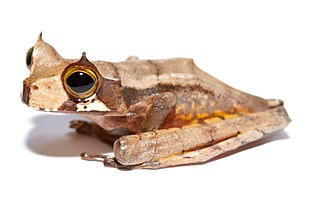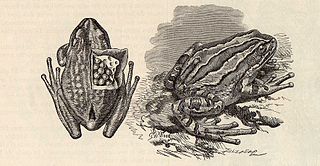
Gastrotheca is a genus of frogs in the family Hemiphractidae. They are found in Central America south of Costa Rica and in South America. Most species occur in the American Cordillera from southern Costa Rica to north-western Argentina. This genus makes up the bulk of marsupial frog diversity; formerly it was placed in the "Leptodactylidae" assemblage.

Griswold's ameiva is a species of lizard in the family Teiidae. The species is endemic to Antigua and Barbuda, where it is found on both islands. It is also known as the Antiguan ameiva or the Antiguan ground lizard.

Dendropsophus sarayacuensis is a species of frog in the family Hylidae.
Gastrotheca abdita is a species of frog in the family Hemiphractidae. It is endemic to Peru and only known from the Cordillera Colán in the Amazonas Region. The specific name abdita is Latin for "exiled" or "removed" and refers to the geographic isolation of the Cordillera Colán. Common name Cordillera Colan marsupial frog has been coined for it.
Gastrotheca atympana is a species of frog in the family Hemiphractidae. It is endemic to Peru and only known from its type locality in the Pampa Hermosa National Sanctuary, Junín Region. It lacks an external tympanum, hence the specific name atympana.

Gastrotheca dunni is a species of frog in the family Hemiphractidae. It is endemic to the northern part of the Cordillera Occidental in northern Antioquia, Colombia. The specific name dunni honors Emmett Reid Dunn, an American herpetologist. Common name Dunn's marsupial frog has been coined for it.

Gastrotheca excubitor is a species of frog in the family Hemiphractidae. It is endemic to southern Peru and occurs in the Amazonian slopes and crests of the Cordillera Oriental in the Cusco Region; records from the Cajamarca Region are likely erroneous. It is likely to include cryptic species. Common name Abra Acanacu marsupial frog has been coined for it.

Gastrotheca marsupiata is a species of frog in the family Hemiphractidae. It is found in the Amazonian drainage systems of Andes from central Peru to southern Bolivia. Its common names are marsupian frog, common marsupial frog, and for now synonymized Leptodactylus/Eleutherodactylus andicola, Boettger's robber frog. It is a locally common frog present in primary, secondary and disturbed cloud and montane forests in the valleys of the central Andes.
The Helena's marsupial frog is a species of frog in the family Hemiphractidae. It is endemic to the Páramo de Tamá on the Venezuelan-Colombian border and occurs in Apure and Táchira states of Venezuela and Norte de Santander Department on the Cordillera Oriental of Colombia. It is named after Helen Gaige, an American herpetologist.
Gastrotheca lateonota is a species of frog in the family Hemiphractidae. It is known from its type locality, El Tambo near Canchaque, Cordillera de Huancabamba, at an elevation of 2,770 m (9,090 ft) asl in Peru, and from the area of Chillacoche in the El Oro Province of Ecuador. Its natural habitat is cloud forest. Habitat loss is a possible threat.
Gastrotheca microdiscus is a frog species in the frog family Hemiphractidae. It is endemic to southeastern Brazil between southern São Paulo and Santa Catarina states. Its natural habitats are undisturbed primary forests. It is a canopy species hiding in bromeliads. It is not considered threatened by the IUCN.

Gastrotheca monticola is a species of frog in the family Hemiphractidae. It is endemic to Peru; records from Ecuador probably refer to other species. Gastrotheca lojana was formerly considered a subspecies of this species, but is now treated as a full species.
Gastrotheca ochoai is a species of frog in the family Hemiphractidae. It is endemic to southern Peru and occurs in the interandean valleys on the eastern face of the Andes. The specific name ochoai honors Oscar Ochoa Mendieta, a biology professor from the National University of Saint Anthony the Abbot in Cuzco who helped the species descriptors during the field work. Common name Chilca marsupial frog has been coined for this species.
Gastrotheca pacchamama is a species of frog in the family Hemiphractidae. It is endemic to Peru and only known from the Ayacucho Region in the Cordillera Oriental.
Gastrotheca rebeccae is a species of frog in the family Hemiphractidae. It is endemic to Peru and known from the eastern slopes of the Cordillera Oriental in the Ayacucho Region, at elevations of 2,440–2,970 m (8,010–9,740 ft) asl. The specific name honours Dr. Rebecca Pyles from the East Tennessee State University.
Gastrotheca stictopleura is a species of frog in the family Hemiphractidae. It is endemic to Peru and known from the southern end of the Cordillera Azul in Huánuco, Pasco, and southern Junín Regions at elevations of 2,500–3,090 m (8,200–10,140 ft) asl. Its natural habitat is cloud forest, but it can also occur in disturbed forest and pastures with trees. It is threatened by habitat loss caused by agriculture, logging and human settlement.
Gastrotheca testudinea is a species of frog in the family Hemiphractidae. It has a widespread latitudinal range along the eastern (Amazonian) slopes of the Andes of Ecuador, Peru, and Bolivia.
Gastrotheca zeugocystis is a species of frogs in the family Hemiphractidae. It is endemic to Peru and only known from its type locality on the Cordillera de Carpish, Huánuco Region. The specific name zeugocystis refers to the paired brood pouches in this species.
Phrynopus oblivius is a species of frogs in the family Craugastoridae. It is endemic to central Peru and only known from near its type locality near Maraynioc, in the Tarma Province, Junín Region, at about 3,210–3,220 m (10,530–10,560 ft) asl. It is known from a collection in 2005; there has been no later surveys for the species.
Benjamin Shreve (1908–1985) was an American amateur herpetologist. He was from a wealthy Boston family of jewellers and worked at the Harvard Museum of Comparative Zoology as a volunteer. He was trained by Arthur Loveridge to deal with materials from elsewhere than Africa. Shreve described many species from the West Indies together with Thomas Barbour. In these papers, Shreve is said to have done the "spadework" while Barbour wrote "florid" introductions.







